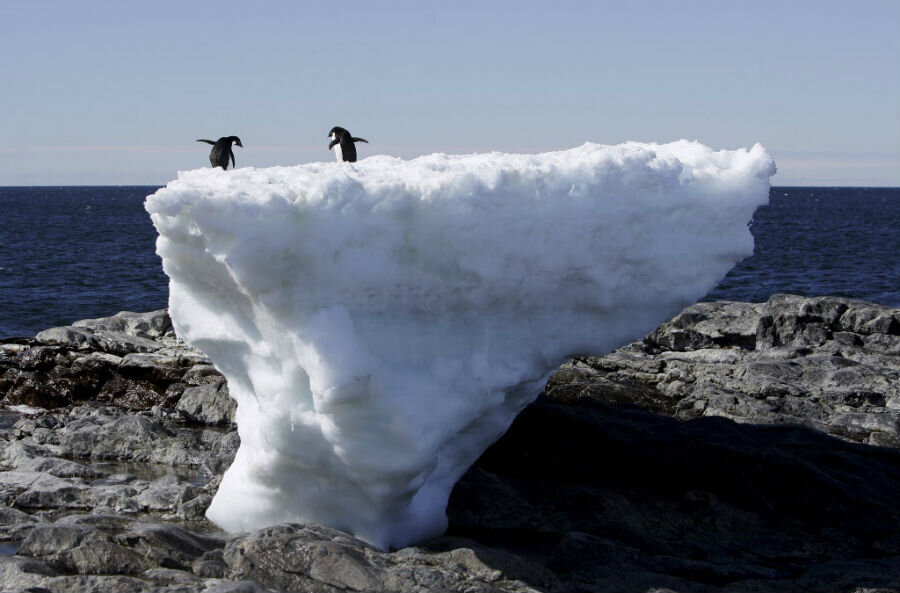As Antarctic ice shrinks from climate change, will Adélie penguins disappear?
Loading...
For millions of years the Adélie penguins have thrived within the natural ebb and flow of temperatures on the Antarctic continent. During colder periods, when glaciers would expand to cover the penguins' preferred rocky breeding grounds, the species' colonies would relocate. During warmer periods when glacier ice would melt, revealing the rocky earth, the penguin colonies would return to old nesting areas.
But this way of life may no longer be sustainable for these penguins, according to a study published Wednesday in the journal Scientific Reports. Instead of being able to relocate with natural climate change as in eras past, Adélie penguins will begin to disappear in coming decades as sea temperatures rise.
By 2060, 30 percent of current Adélie colonies, or 20 percent of the overall population, may be in decline, researchers say. And approximately 60 percent of the colonies may be in decline by 2099.
"It is only in recent decades that we know Adélie penguin population declines are associated with warming, which suggests that many regions of Antarctica have warmed too much and that further warming is no longer positive for the species," lead author Megan Cimino, who earned her doctoral degree at the University of Delaware in May and is now a postdoctoral scholar at Scripps Institute of Oceanography, said in a press release. Dr. Cimino worked with a team of researchers from University of Delaware and other research institutions and was funded through NASA's biodiversity program.
The team used a combination of methods, old and new, to gain a clearer picture of how climate change will effect the Adélie penguins, which have nesting grounds all over Antarctica, including on the West Antarctic Peninsula, one of the fastest warming regions on the planet.
The researchers used images from space to study to the habitat and populations of the penguins. By looking at satellite images from 1981 to 2010, scientists were able observe sea ice and bare rock locations and sea surface temperature – all factors that affect the species' breeding patterns and habitat. The images also showed where the penguin populations were, and were not, during this time period.
The satellite perspective, which provides a big-picture view of everywhere the penguins can and cannot live on the continent is a "key advance" in species study, team member Heather J. Lynch, assistant professor in the Department of Ecology and Evolution at Stony Brook University, said in the statement.
It "opens up new avenues for modeling habitat suitability," she said.
By coupling this observed satellite data with global climate models for the coming decades, the scientists were able to make their predictions about what regions of Antartica the penguins will be able to breed and raise their young.
Those zones are unequivocally shrinking, the research showed, and the main cause is likely warming sea temperatures.
And this "climate novelty" has already had an impact on the Adélie penguin population, which are one of only 17 penguin species in the world.
Cimino says that the population is already in decline in the southern and northern regions of the West Antarctic Peninsula (WAP), as well as nearby islands. She says that penguin colonies in that area have already declined by at least 80 percent since the 1970s.
"Within this region we saw the most novel climate years compared to the rest of the continent. This means the most years with warmer than normal sea surface temperature. These two things seem to be happening in the WAP at a higher rate than in other areas during the same time period," Cimino said.
The study notes that within Antartica there are several refugia – areas with relatively unaltered climate – where the Adélie penguins could go to breed when rising sea temperatures shut them out of other regions, like the WAP. These refugia offer some glimmers of hope.
Some of these places, such as the Cape Adare region in the Ross Sea, have been used by the penguins during past periods of climate warming, said Cimino.
While refugia could stem a species-wide decline, they are not a permanent fix. The areas will likely exist beyond 2099, the researchers say, but how permanent they will be is unknown.
However, Cimino says that research, like this, that pinpoints how and where species are affected by climate change can lead to improved management of ecosystems in the future.







